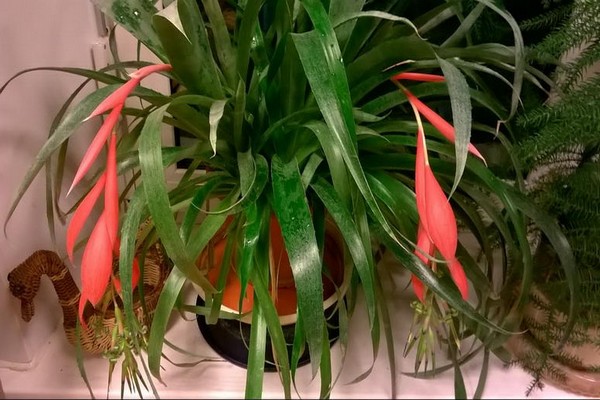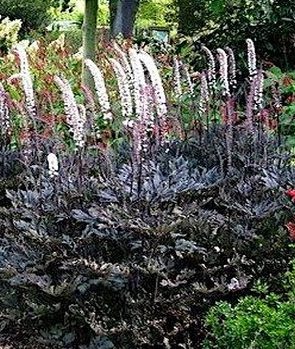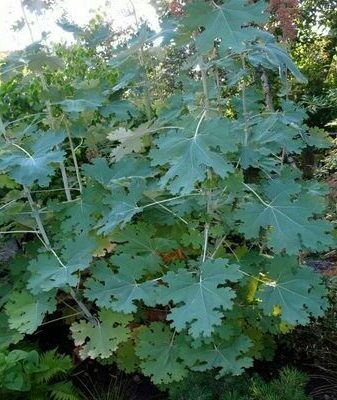Bilbergia
Content:
Bilbergia - billbergia - quite popular blooming indoor plant, which can often be found in rooms or on the balconies of our country. Perhaps everyone loved it so much for its appearance, and, perhaps, for its unpretentiousness. In any case, in this article you will learn how to care for Bilbergia, how to propagate this flower and much more.

Bilbergia: photo by billbergia
Indoor plant Bilbergia: variety description
In fact, Bilbergia billbergia is a genus that has no less than sixty different plant species. This species belongs to the family of so-called bromeliads, which grow mainly in America, both Central and South. In these parts of the world, droughts and very hot days are frequent, and therefore the Bilbergias have learned to adapt to these conditions and have become very unpretentious in care.
The entire appearance of Bilbergia suggests that this plant has passed its evolutionary, trying to escape from the heat and from the lack of moisture. Therefore, it acquired belt-like foliage, which remarkably stores fluids in itself. Also, some species that developed in especially arid conditions have developed the ability to cover their surface with a special coating that does not allow moisture to evaporate from Bilbergia. Also, some of the species have small thorns along the edges of their banded leaves, which serve as additional protection.
However, of course, Bilbergia is appreciated not for its thorns or ability to store moisture, but for its incredibly beautiful flowering. We owe it to him for the fact that this plant can so often be seen standing in apartments and offices. And, no less important, Bilbergia blooms not even once, but as much as twice a year. It is not hard to guess that it blooms in spring and autumn. Flowers of Bilbergia can boast of their length, because each of them, if it were not painted in a different color, would be difficult to distinguish from the foliage. However, the rich, bright shade inherent in the Bilbergia flowers still makes them stand out.
Flowers grow straight from the center of the plant, where each ribbon leaf originates. And, perhaps, it is not entirely correct to say that Bilbergia has long flowers. The fact is that each flower is on a rather long peduncle, which, moreover, is painted in the same color as itself. Therefore, it seems that the flowers are long.

Throughout the entire period of growth, Bilbergia constantly grows small underground and aboveground shoots, which form their own small leaf rosettes at their tips. When cold weather sets in, with the end of the flowering period, the current year's rosette dies off, and already next spring, small shoots that were launched last year begin to grow, develop and bloom. Thus, in a relatively short period of time, just one individual of Bilbergia can turn into a rather impressive colony, which will occupy a rather large territory.
Bilbergia: types of indoor plants
As already mentioned, there are about sixty species of Bilbergia, each of which is grown as an ornamental plant. However, some of them, for completely different reasons, are not suitable for home growing. However, the best variety that exists perfectly at home is perhaps Bilbergia drooping... You may have heard of her under a completely different name: "The Queen's Tears". In height, the houseplant Bilbergia drooping reaches up to forty centimeters, and the peduncles, along with the flowers, stretch up to thirty. Each of the large flowers is a rich, attractive pink, comparable to the plumage of a flamingo. There are, of course, not fully disclosed flowers. They have a purple hue at their tips.
Another, no less popular and, of course, no less beautiful variety is the flower Bilbergia Zebra. This species is especially popular with collectors who collect exotic and unusual plants in their garden. Compared to the previous species, Bilbergia Zebra-like has slightly more impressive dimensions. Its foliage reaches a length of up to eighty centimeters, and sometimes even a meter. In addition, the color of the foliage itself is very bright and interesting. It can be described as olive or lime green. And in addition to beautiful foliage, this Bilbergia has bright flowers.
Of course, there are many more species that are great for growing at home, but most of them are either significantly inferior in quality to those suggested above, or are like two peas in a pod.
Bilbergia: home care

Bilbergia: photos
In fact, caring for Bilbergia at home will not be difficult even for those who are not too fond of floriculture, because over thousands of years of life in adverse conditions, this plant has learned to survive perfectly. However, this does not mean that the Bilbergia plant can be handled at random. This is also important to understand.
Where to put Bilbergia?
Most often, Bilbergia is planted in pots and placed on windowsills, however, this is far from the only place where it will be comfortable. Alternatively, you can consider the cultivation of Bilbergia on the so-called "bromeliad tree". It can be either an inanimate structure made of pieces of bark and snags of a former tree, or a completely living plant on which we will place the Bilbergia plant. To do this, we need to pull it out of the pot and free the roots from the clumps of earth adhering to them. After that, each root is solidly wrapped in sphagnum moss. And already in this state, the roots are attached to the snag.
Instead of erecting a full-fledged structure of branches, snags and bark, you can simply put a piece of log on a shelf or hang on the wall. It will look no less interesting and very stylish.
The only problem that you will have to face when placing Bilbergia in this way is the difficulty in providing the necessary moisture to the moss.

Bilbergia flower: photo
Lighting
Bilbergia flower is one of those plants that cannot live without light. However, direct, baking sunlight should be avoided, because the light that this plant loves must be diffused. Therefore, the western or eastern windows will be the ideal place for planting Bilbergia. Accommodation, both on the northern and southern sides, is highly undesirable, since there simply will not be enough lighting on the first Bilbergia, but on the second there will be too much hassle in order to shade the plant every day at noon.
Air temperature
This plant is not particularly whimsical to the temperature at which it will have to grow. However, there are still optimal standards and it is advisable to adhere to them. The life cycle of Bilbergia is divided into a growing season and a dormant period. So, during the growing season, there are practically no frames limiting the temperature of the room in which Bilbergia grows. However, there are standards, and they state that the optimum temperature for this plant is between twenty and thirty degrees Celsius. However, during the rest period, the recommended temperature serves up to almost fifteen degrees.This period cannot be neglected, since it is during this period that the kidneys develop most actively in Bilbergia.
Nevertheless, the houseplant Bilbergia also withstands critically low temperatures quite well: up to two to three degrees Celsius. It also copes well with drafts and is practically not afraid of them. However, Bilbergia will not be able to survive at such a temperature, which lasts for a long time. Even if the plant does not die, it will definitely get sick. The exact same effect will be observed at temperatures below thirteen degrees.
How to water a houseplant Bilbergia?

Bilbergia: photos
Even under the most common conditions, the Bilbergia houseplant should be watered regularly and abundantly. However, on particularly hot days, both the quality and frequency of watering should be increased. Your guideline should be soil moisture. Water should never stagnate in it, but the topsoil should never dry out. Simply put, you need to stick to the golden mean. Watering is slightly different during the dormant period, since at this time the drying of the top layer of soil in the pot is permissible, however, it should not be left dry for a long time either.
Irrigation of Bilbergia has some more features. In the hottest seasons, in summer - at the end of spring, watering is not done on the soil, but directly on the leaf outlet itself. However, such a procedure is permissible and must be carried out only if the temperature of the room in which Bilbergia is growing is above twenty degrees Celsius. Otherwise, watering of the outlet is abolished and ordinary watering into the soil is carried out. Also, the leaf outlet must be dry in winter and in one more case: after the end of the flowering period of the plant. If you water the outlet during one of these periods, you can bring the leaves to rot.
Since we have already talked about how to place Bilbergia on the “bromelium tree”, it would be necessary to tell about how to water it there. This is done a little more difficult than with ordinary watering: the plant is removed from the tree and the news of the moss is lowered into slightly warm water for twenty minutes, after which it is taken out of the container and allowed to dry. Now you can return Bilbergib to its place. Such watering is carried out only when the moss is completely dry.
The water in which the moss is saturated with moisture must also have certain qualities. First, before watering, it must settle for at least one day. In addition, the water must be soft and, as already mentioned, a little warm. It is also necessary to disinfect the water before watering. To do this, you can boil it or just add a little citric acid to the container.
Humidity

Bilbergia: photos
Humidity is a very important factor when growing Bilbergia, if you want it to produce beautiful flowers and not get sick, of course. Moreover, there should be really a lot of moisture: at least seventy to eighty percent. Therefore, an ordinary sprayer will become an extremely useful acquisition. Although, if for some reason you cannot or do not want to purchase it, you can spray Bilbergia from a spray bottle. This is also a necessary procedure when the air temperature is too high.
However, there is also a period when it is completely undesirable to moisturize Bilbergia. It is the period of flowering, when a drop of water accidentally falling on the petal can cause dark spots on it, which, of course, is completely undesirable.
Soil for Bilbergia
In fact, you can plant a houseplant Bilbergia in almost any soil. The main qualities that it should have are sufficient looseness, moisture conductivity and ventilation. However, it is much easier than trying to prepare a suitable soil mixture for yourself, conjuring with ingredients, will go to the store and buy a universal soil.The chances that it will not fit the flower of Bilbergia tend to zero. However, if you still crave to create, you will need to mix several types of soil (peat, coniferous and leafy), and also add humus, sand and a little charcoal to retain moisture. And, of course, do not forget that this plant, like air, needs a solid drainage layer.
Top dressing

Bilbergia flower: photo
You don't need to fertilize Bilbergia too much. Maximum - only once every two weeks during the growing season. There is also no need to select a suitable fertilizer: it has long been selected for you, because there is a special complex feeding for bromeliad plants. However, fertilizer for ornamental plants of all species and families is also suitable for Bilbergia. However, there is also a very important rule: what dosage would not be indicated on the package, always pour out only half of the proposed amount.
It is also important to ensure that the fertilizer used does not contain too much nitrogen. In large quantities, it is very harmful to Bilbergia.
How to transplant Bilbergia?
Fortunately, in this regard, Bilbergia is very simple. The root system of this plant grows rather slowly, and therefore it will need to replace the pot very rarely. However, if you see that the current housing in Bilbergia is getting cramped, it is still necessary to take care of the new one. By the way, if the plant has grown, you don't even have to look for a bigger pot, but simply divide the existing bush. However, this is already, in fact, reproduction, which we will talk about in the next paragraph.
How to propagate Bilbergia?
As already mentioned, the fastest and most effective way to reproduce Bilbergia is propagation with the help of shoots. A decent amount of them grows on the mother plant, and therefore you will have plenty to choose from. After selecting, cutting and planting a seedling, it will take at least two more years before it begins to bloom. However, most often this number is equal to three years. Also, as mentioned in the last paragraph, adult Bilbergia can be quite divided, having received two so-called delenki, which will have to bloom next year.
You can also propagate Bilbergia by seeds, but this method is very time consuming, effortless and has the lowest percentage of effectiveness. So you can use it exclusively as an experiment.

Pests
Here Bilbergia is no different from most ornamental plants, which are often the target of aphids, scale insects and spider mites. Insecticides will help to cope with them, but be careful when using them: they are poisonous.
Possible growing problems
Most often, growing Bilbergia, you will encounter the following problems:
- Drying of the tips of the leaves of Bilbergia. This is due to the fact that the plant is not watered enough.
- It is also possible that the leaf rosette begins to lose its structure. This is due to the fact that Bilbergia lacks light.
- Specks on the leaves most likely indicate that your plant has been burned and should be kept out of direct sunlight.
- If the rosette begins to rot before the flowers appear on the Bilbergia, this is an indication that there is too much moisture in the soil.
Conclusion
Bilbergia is a houseplant that can decorate any room. And, given how easy it is to care for it, absolutely anyone can enjoy the beauty of its foliage in their own home. The main thing is to follow simple rules and follow the instructions, and then your Bilbergia will be able to show itself exclusively from its best side, and it will definitely attract the eyes of the guests of your house.




